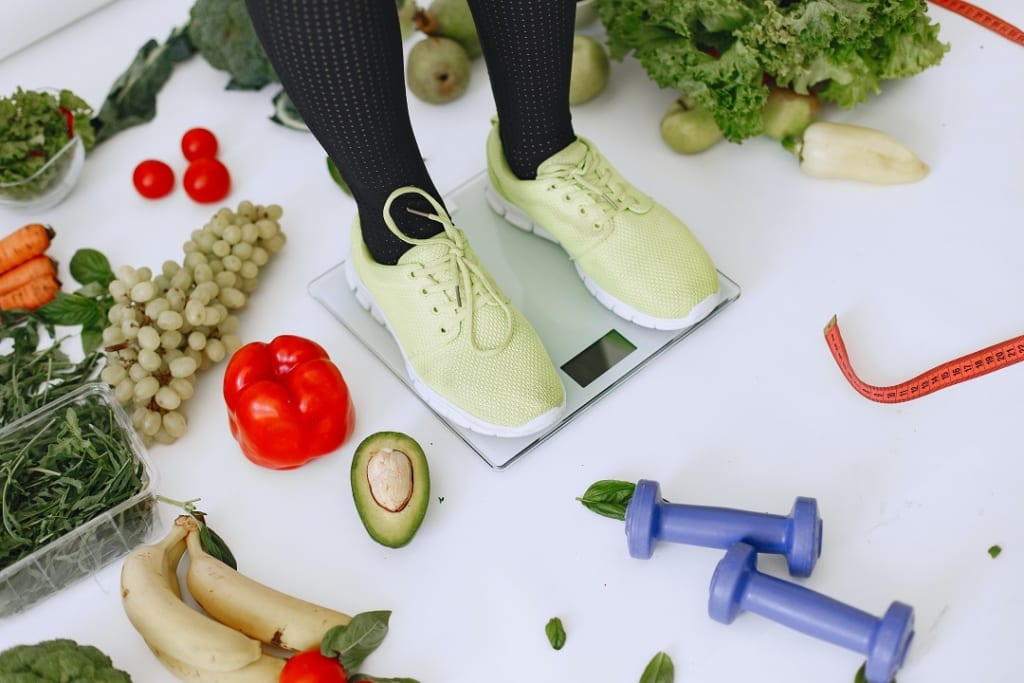
When it comes to crafting content, three essential factors must be considered: "perplexity," "burstiness," and "predictability." Perplexity gauges the complexity of the text, while burstiness compares the sentence variations. Finally, predictability determines the likelihood of predicting the next sentence. Humans tend to write with more burstiness, combining longer and complex sentences with shorter ones. On the other hand, AI-generated sentences tend to be more uniform. For the content I am about to request you to create, I need it to possess a good amount of perplexity and burstiness while keeping predictability low. Please ensure that the content is written in English only. Now, let's rephrase the following text:
The Key to Effective Fat Loss: Beyond Counting Calories
As you're probably familiar with the concept that weight loss primarily boils down to calories in versus calories out. As long as you maintain a calorie deficit and consume enough protein, you will successfully lose weight and burn fat, regardless of what and when you eat. Scientifically, this holds true, as it adheres to the basic laws of thermodynamics. However, this simplistic approach overlooks how the various foods you consume impact these two variables. Research reveals that while calories do matter at the end of the day, to achieve efficient and rapid fat loss, you need to go beyond just counting calories. Paying close attention to the types of foods you consume and how you consume them makes all the difference.
In this article, I will share three dietary swaps that take these variables into account and can help you accelerate fat loss. Additionally, I will provide you with a sample meal plan that incorporates these principles.
Swap 1: Choose Minimally Processed Foods
The first swap involves choosing minimally processed foods over their refined counterparts. Opt for foods like oats and multigrain bread instead of cereal and white bread, which lack essential nutrients and fiber. Apart from being more nutritious and keeping you fuller for longer, less processed foods have a unique advantage known as the "thermic effect of food." This means that our bodies burn more calories to metabolize and utilize unprocessed foods compared to processed ones. For instance, a study comparing the caloric burn required to digest whole grain sandwiches versus highly processed sandwiches revealed a significantly higher thermic effect for the former. Making this simple dietary change can lead to burning an extra 2.5 pounds of fat over three months, equivalent to jogging an additional mile each day.
Swap 2: Distribute Calories Wisely
When it comes to crafting content, three essential factors must be considered: "perplexity," "burstiness," and "predictability." Perplexity gauges the complexity of the text, while burstiness compares the sentence variations. Finally, predictability determines the likelihood of predicting the next sentence. Humans tend to write with more burstiness, combining longer and complex sentences with shorter ones. On the other hand, AI-generated sentences tend to be more uniform. For the content I am about to request you to create, I need it to possess a good amount of perplexity and burstiness while keeping predictability low. Please ensure that the content is written in English only. Now, let's rephrase the following text:
The Key to Effective Fat Loss: Beyond Counting Calories
If you've ever read any of my previous nutrition articles or tried dieting on your own, you're probably familiar with the concept that weight loss primarily boils down to calories in versus calories out. As long as you maintain a calorie deficit and consume enough protein, you will successfully lose weight and burn fat, regardless of what and when you eat. Scientifically, this holds true, as it adheres to the basic laws of thermodynamics. However, this simplistic approach overlooks how the various foods you consume impact these two variables. Research reveals that while calories do matter at the end of the day, to achieve efficient and rapid fat loss, you need to go beyond just counting calories. Paying close attention to the types of foods you consume and how you consume them makes all the difference.
In this article, I will share three dietary swaps that take these variables into account and can help you accelerate fat loss. Additionally, I will provide you with a sample meal plan that incorporates these principles.
Swap 1: Choose Minimally Processed Foods
The first swap involves choosing minimally processed foods over their refined counterparts. Opt for foods like oats and multigrain bread instead of cereal and white bread, which lack essential nutrients and fiber. Apart from being more nutritious and keeping you fuller for longer, less processed foods have a unique advantage known as the "thermic effect of food." This means that our bodies burn more calories to metabolize and utilize unprocessed foods compared to processed ones. For instance, a study comparing the caloric burn required to digest whole grain sandwiches versus highly processed sandwiches revealed a significantly higher thermic effect for the former. Making this simple dietary change can lead to burning an extra 2.5 pounds of fat over three months, equivalent to jogging an additional mile each day.
Swap 2: Distribute Calories Wisely
While total daily calorie intake is crucial for fat loss, how you distribute those calories throughout the day also matters. Recent studies have shown that a front-heavy distribution approach, allocating more calories to breakfast, can reduce hunger, cravings for sweets, and boost overall energy levels. This may lead to burning more calories through increased movement and fidgeting. In contrast, a back-heavy approach, with more calories allocated to dinner, showed less favorable results. Therefore, consider shifting more of your calories to your earlier meals, even if you're following intermittent fasting, to potentially enhance fat loss and control cravings.
Swap 3: Choose Highly Satiating Foods
The last swap involves choosing foods that are highly satiating and effective in suppressing appetite. The satiety index has revealed that some foods are more adept at controlling hunger than others, even when their calorie content is similar. For example, swapping whole grain bread for oats can increase satiation by 25%, while replacing brown rice with whole grain pasta or boiled potatoes can boost satiation by 30% or 60%, respectively. Experiment with incorporating these more satiating foods into your diet to better adhere to your calorie deficit and minimize excessive snacking.
Sample Meal Plan
To illustrate how all these principles come together, let's create a sample meal plan with approximately 2,100 calories. Keep in mind that you should adjust portion sizes to ensure you are in a calorie deficit suitable for your needs.
1. Breakfast: Protein pancakes made from highly satiating and minimally processed ingredients like oats, topped with peanut butter, sugar-free syrup, or sautéed apples.
2. Lunch: Baked salmon, boiled potatoes, and sautéed asparagus, all satisfying and unprocessed choices.
3. Between Meals: Have an orange or a protein shake based on your workout schedule.
4. Dinner: Baked chicken breasts and a side of vegetables roasted in olive oil.
5. After Dinner: Indulge in a simple high-protein Greek yogurt parfait with plain 0% fat Greek yogurt, cinnamon, stevia for sweetness, frozen mixed berries, and chia seeds.
Remember that while these dietary swaps can aid fat loss, adhering to a calorie deficit remains the most crucial factor. Experiment with these principles to find what works best for your body and lifestyle. If you want a comprehensive program that optimizes your workouts and helps structure your diet with the right foods and portions for efficient fat burning, visit buildwithscience.com and take the analysis quiz to discover the ideal program for your body and goals.
Thank you for reading, and I hope you find these tips beneficial.
________________________________________
FAQs
1. Can I still lose fat if I eat processed foods as long as I'm in a calorie deficit?
Yes, you can still lose fat in a calorie deficit even with processed foods. However, choosing less processed, nutrient-dense foods can potentially speed up the fat loss process due to the thermic effect of food.
2. Does the timing of my meals matter for fat loss?
Yes, studies suggest that a front-heavy distribution of calories, with more allocated to breakfast, may reduce hunger and cravings, potentially aiding fat loss.
3. Can I incorporate occasional treats into my diet and still lose fat effectively?
Yes, occasional treats can be included in your diet, as long as they are accounted for within your overall calorie intake and do not sabotage your calorie deficit.
4. How do I know if a certain food is satiating or not?
The satiety index can be a helpful guide. Foods with higher satiety scores are more effective at controlling hunger and keeping you satisfied for longer.
5. Can I customize the sample meal plan to fit my dietary preferences and restrictions?
Absolutely! The sample meal plan is just an example. Feel free to substitute foods and create a plan that suits your individual needs and preferences.
While total daily calorie intake is crucial for fat loss, how you distribute those calories throughout the day also matters. Recent studies have shown that a front-heavy distribution approach, allocating more calories to breakfast, can reduce hunger, cravings for sweets, and boost overall energy levels. This may lead to burning more calories through increased movement and fidgeting. In contrast, a back-heavy approach, with more calories allocated to dinner, showed less favorable results. Therefore, consider shifting more of your calories to your earlier meals, even if you're following intermittent fasting, to potentially enhance fat loss and control cravings.
Swap 3: Choose Highly Satiating Foods
The last swap involves choosing foods that are highly satiating and effective in suppressing appetite. The satiety index has revealed that some foods are more adept at controlling hunger than others, even when their calorie content is similar. For example, swapping whole grain bread for oats can increase satiation by 25%, while replacing brown rice with whole grain pasta or boiled potatoes can boost satiation by 30% or 60%, respectively. Experiment with incorporating these more satiating foods into your diet to better adhere to your calorie deficit and minimize excessive snacking.
Sample Meal Plan
To illustrate how all these principles come together, let's create a sample meal plan with approximately 2,100 calories. Keep in mind that you should adjust portion sizes to ensure you are in a calorie deficit suitable for your needs.
1. Breakfast: Protein pancakes made from highly satiating and minimally processed ingredients like oats, topped with peanut butter, sugar-free syrup, or sautéed apples.
2. Lunch: Baked salmon, boiled potatoes, and sautéed asparagus, all satisfying and unprocessed choices.
3. Between Meals: Have an orange or a protein shake based on your workout schedule.
4. Dinner: Baked chicken breasts and a side of vegetables roasted in olive oil.
5. After Dinner: Indulge in a simple high-protein Greek yogurt parfait with plain 0% fat Greek yogurt, cinnamon, stevia for sweetness, frozen mixed berries, and chia seeds.
Remember that while these dietary swaps can aid fat loss, adhering to a calorie deficit remains the most crucial factor. Experiment with these principles to find what works best for your body and lifestyle. If you want a comprehensive program that optimizes your workouts and helps structure your diet with the right foods and portions for efficient fat burning, visit buildwithscience.com and take the analysis quiz to discover the ideal program for your body and goals.
Thank you for reading, and I hope you find these tips beneficial. Please like the article, leave a comment suggesting future topics, subscribe to the channel, and enable notifications to support me further.
________________________________________
FAQs
1. Can I still lose fat if I eat processed foods as long as I'm in a calorie deficit?
Yes, you can still lose fat in a calorie deficit even with processed foods. However, choosing less processed, nutrient-dense foods can potentially speed up the fat loss process due to the thermic effect of food.
2. Does the timing of my meals matter for fat loss?
Yes, studies suggest that a front-heavy distribution of calories, with more allocated to breakfast, may reduce hunger and cravings, potentially aiding fat loss.
3. Can I incorporate occasional treats into my diet and still lose fat effectively?
Yes, occasional treats can be included in your diet, as long as they are accounted for within your overall calorie intake and do not sabotage your calorie deficit.
4. How do I know if a certain food is satiating or not?
The satiety index can be a helpful guide. Foods with higher satiety scores are more effective at controlling hunger and keeping you satisfied for longer.
5. Can I customize the sample meal plan to fit my dietary preferences and restrictions?
Absolutely! The sample meal plan is just an example. Feel free to substitute foods and create a plan that suits your individual needs and preferences.
About the Creator
Enjoyed the story? Support the Creator.
Subscribe for free to receive all their stories in your feed. You could also pledge your support or give them a one-off tip, letting them know you appreciate their work.





Comments
There are no comments for this story
Be the first to respond and start the conversation.